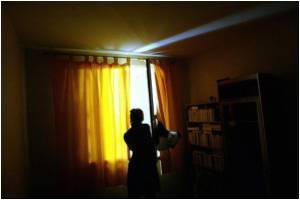After 13 years of wandering the streets and homeless shelters, Maureen Brosnahan was given a tiny apartment with no strings attached last year.

"You always think that something better is going to happen. And for me, this happened," she says of the 16-room dorm-style building run by Open Arms Housing, a local non-profit that houses homeless women.
"It doesn't hit you until you're in for a year or so, and then it's like, 'Bam! I'm inside'... You don't have to go to a church to take a shower."
The 53-year-old is one of thousands of people across the United States who have been moved into permanent housing in recent years as part of a new approach that supporters believe could end homelessness within a decade.
The "Housing First" strategy calls for identifying people who are most likely to die on the streets -- drug addicts, the mentally ill and those with chronic health problems -- and immediately moving them into their own flats.
Perhaps the most ambitious program is the 100,000 homes campaign, a nationwide effort first launched in New York that aims to eliminate chronic homelessness by providing homes for 100,000 people by 2013.
Advertisement
Under traditional federal housing programs, applicants had to spend years on waiting lists and were barred from housing by drug or other convictions, a process that offered little hope for the most vulnerable.
Advertisement
The Housing First approach, by contrast, sees permanent housing and supporting services as prerequisites for curing the other ills that plague the homeless.
"If you're living on the street, and you're anxious, you're drinking maybe a pint of whiskey overnight, because you're trying to stay awake and trying to stay warm and you don't want the rats to bite you and you don't want somebody to beat you up," Kaufman says.
"You move into an apartment where it's safe, you may have a couple of beers and fall asleep in front of the TV."
The government has also come around to the approach, incorporating Housing First into a comprehensive, $1.4 billion program to try to end chronic homelessness by 2015 and family homelessness by 2020.
"We know there are strategies out there that actually work. It's a matter of committing to those strategies and making sure we keep that momentum going," says Anthony Love, deputy director of the Interagency Council on Homelessness, which brings together 19 federal departments and agencies.
Officials and advocates alike argue that housing the homeless is not only the most humane solution but also the cheapest, since it reduces the cost of emergency medical care and law enforcement.
There are fears, however, that as governments at every level are forced to slash budgets to cope with the lingering economic crisis, the available funding may not match the ambitious goals set by Housing First campaigns.
"There's just less local money available for housing as state and local budgets have gone down," says Jeremy Rosen, program director at the National Law Center on Homelessness and Poverty.
"Ending homeless at this point is really not a mystery in terms of tactics, it's a question of being able to get the resources."
Others fear that overly zealous officials will view Housing First as an alternative to emergency shelters at a time when the economic crisis is leaving more newly homeless people, including families, in search of beds.
Of the roughly 650,000 homeless people in America nearly 40 percent live "unsheltered" on the street, according to the National Alliance to End Homelessness.
"We're definitely in favor of putting resources into permanent housing. We just don't want resources to be pulled out of emergency shelter until there is a drop in demand," says Andy Silver, an attorney with the Washington Legal Clinic for the Homeless.
When Washington's then-mayor Adrian Fenty embraced the Housing First approach in 2008 he also closed a major shelter downtown that had provided 400 beds, pushing dozens of homeless people into an adjacent park.
"They were saying if we put one person in housing we can take away one emergency shelter bed, and that math doesn't work out," Silver says.
In the park, just a few blocks from the White House, Blair gathers together the plastic bags and suitcases that have carried all her possessions since she lost her apartment a year ago following her mother's death.
The 42-year-old and her 68-year-old companion Kathalene -- who declined to give their last names out of fear, or perhaps paranoia, of local authorities -- spend their days here before heading to a hypothermia shelter in a church basement that opens when the temperature drops below freezing.
"People look at you like you have a disease, like you have a plague," Blair says.
They will sleep with all of their belongings close by -- stealing is a constant fear in the shelters -- and they will have to be out by 7:00 am the following morning.
They have never heard of Housing First programs, and they say the shelters are as crowded as ever.
"There are faces I have never seen before," Kathalene says, before heading off into the darkening cold. "Every night it's new faces."
Source-AFP










